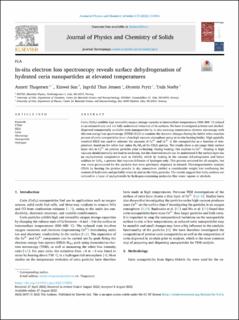| dc.contributor.author | Thøgersen, Annett | |
| dc.contributor.author | Sun, Xinwei | |
| dc.contributor.author | Jensen, Ingvild Julie Thue | |
| dc.contributor.author | Prytz, Øystein | |
| dc.contributor.author | Norby, Truls | |
| dc.date.accessioned | 2023-02-14T14:13:36Z | |
| dc.date.available | 2023-02-14T14:13:36Z | |
| dc.date.created | 2022-10-05T13:20:45Z | |
| dc.date.issued | 2022 | |
| dc.identifier.citation | Journal of Physics and Chemistry of Solids. 2022, 170 1-7. | en_US |
| dc.identifier.issn | 0022-3697 | |
| dc.identifier.uri | https://hdl.handle.net/11250/3050792 | |
| dc.description.abstract | Ceria (CeO2) exhibits high reversible oxygen storage capacity at intermediate temperatures (500–800 °C) related to an extraordinary and not fully understood reduction of its surfaces. We have investigated pristine and alcohol-dispersed commercially available ceria nanoparticles by in-situ scanning transmission electron microscopy with electron energy loss spectroscopy (STEM-EELS) to examine the dynamic changes during the initial redox reaction process of ceria nanoparticles in an ultra-high vacuum atmosphere using an in-situ heating holder. High spatially resolved EELS was used to estimate the amounts of Ce3+ and Ce4+ in the nanoparticles as a function of temperature, based on the white-line ratios M5/M4 of the EELS spectra. The results show a nm-range thick surface layer rich in Ce3+ on pristine particles prior to heating. During heating, this oxidises to Ce4+. Heating in high vacuum should normally not lead to oxidation, but the observed results can be understood if the surface layer has an oxyhydroxide composition such as CeOOH, which by heating in the vacuum dehydrogenates and hence oxidises to CeO2, a process that requires diffusion of hydrogen only. This process occurred for all samples, but was more pronounced for the particles that were previously dispersed in ethanol. Thermogravimetric analysis (TGA) by heating the pristine powder in dry atmosphere yielded a considerable weight loss confirming the content of hydroxide and probably water in and on the CeO2 particles. The results suggest that CeO2 surfaces are reduced to a layer of oxyhydroxide by hydrogen-containing molecules like water vapour or alcohols. | en_US |
| dc.language.iso | eng | en_US |
| dc.publisher | Elsevier | en_US |
| dc.rights | Navngivelse 4.0 Internasjonal | * |
| dc.rights.uri | http://creativecommons.org/licenses/by/4.0/deed.no | * |
| dc.subject | Hydrogen | en_US |
| dc.subject | Nanopowder | en_US |
| dc.subject | Microscopy | en_US |
| dc.subject | Ceria | en_US |
| dc.subject | EELS | en_US |
| dc.subject | ETEM | en_US |
| dc.title | In-situ electron loss spectroscopy reveals surface dehydrogenation of hydrated ceria nanoparticles at elevated temperatures | en_US |
| dc.title.alternative | In-situ electron loss spectroscopy reveals surface dehydrogenation of hydrated ceria nanoparticles at elevated temperatures | en_US |
| dc.type | Peer reviewed | en_US |
| dc.type | Journal article | en_US |
| dc.description.version | publishedVersion | en_US |
| dc.rights.holder | © 2022 The Authors. Published by Elsevier Ltd | en_US |
| dc.source.pagenumber | 1-7 | en_US |
| dc.source.volume | 170 | en_US |
| dc.source.journal | Journal of Physics and Chemistry of Solids | en_US |
| dc.identifier.doi | 10.1016/j.jpcs.2022.110955 | |
| dc.identifier.cristin | 2058786 | |
| dc.relation.project | Norges forskningsråd: 197405 | en_US |
| dc.relation.project | Norges forskningsråd: 280868 | en_US |
| dc.relation.project | Norges forskningsråd: 257653 | en_US |
| cristin.ispublished | true | |
| cristin.fulltext | original | |
| cristin.qualitycode | 1 | |

